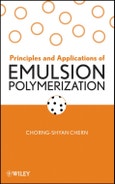This book provides a comprehensive reference on emulsion polymerization methods,focusing on the fundamental mechanisms and kinetics of each process, as well as howthey can be applied to the manufacture of environmentally friendly polymeric materials.
Topics covered include:
- Conventional emulsion polymerization
- Miniemulsion polymerization
- Microemulsion polymerization
- Industrial emulsion polymerization processes (primarily the semibatch and continuous reactions systems)
- The role of various colloidal phenomena in emulsion polymerization
- Important end-use properties of emulsion polymer (latex) products
- Information on industrial applications in paints, coatings, adhesives, paper and board, and more
Table of Contents
Preface.1. Introduction.
1.1. Free Radical Polymerization.
1.2. Emulsion Polymerization.
1.3. Colloidal Stability.
1.4. Some Performance Properties for Industrial Applications.
References.
2. Interfacial Phenomena.
2.1. Thermodynamic Consideration.
2.2. Surfactants.
2.3. Colloidal Stability.
3. Particle Nucleation Mechanisms.
3.1. Micellar Nucleation.
3.2. Homogenous Nucleation.
3.3. Coagulative Nucleation.
3.4. Mixed Mode of Particle Nucleation Mechanisms.
3.5. Surfactant-Free Emulsion Polymerization.
3.6. Experimental Work on Particle Nucleation.
3.7. Nonionic and Mixed Surfactant Systems.
References.
4. Emulsion Polymerization Kinetics.
4.1. Emulsion Polymerization Kinetics.
4.2. Absorption of Free Radicals by Latex Particles.
4.3. Desorption of Free Radicals Out of Latex Particles.
4.4. Growth of Latex Particles.
4.5. Polymer Molecular Weight.
References.
5. Miniemulsion Polymerization.
5.1. Polymerization in Monomer Droplets.
5.2. Stability of Monomer Emulsions.
5.3. Type of Costabilizers in Miniemulsion Polymerization.
5.4. Miniemulsion Polymerization Mechanisms and Kinetics.
5.5. Versatility of Miniemulsion Polymerization.
References.
6. Microemulsion Polymerization.
6.1. Introduction.
6.2. Formation and Microstructure of Microemulsions.
6.3. O/W Microemulsion Polymerization.
6.4. W/O Microemulsion Polymerization.
6.5. Polymerization Continuous or Bicontinuous Phases of Microemulsions.
References.
7. Semibatch and Continuous Emulsion Polymerizations.
7.1. Semibatch Emulsion Polymerization.
7.2. Continuous Emulsion Polymerization.
7.3. Development of Commercial Continuous Emulsion Polymerizations Process.
References.
8. Emulsion Polymerizations in Nonuniform Latex Particles.
8.1. Origin of Nonuniform Latex Particles.
8.2. Seeded Emulsion Polymerizations.
8.3. Factors Affecting Particle Morphology.
8.4. Morphology Development in Latex Particles.
8.5. Polymerization Kinetics in Nonuniform Latex Particles.
9. Applications of Emulsion Polymers.
9.1. Physical Properties of Emulsion Polymers.
9.2. Rheological Properties of Emulsion Polymers.
9.3. Film Formation of Emulsion Polymers.
9.4. Foaming and Antifoaming Agents.
9.5. Wetting.
9.6. Surface Modifications.
9.7. Stability of Latex Products.
Index.








